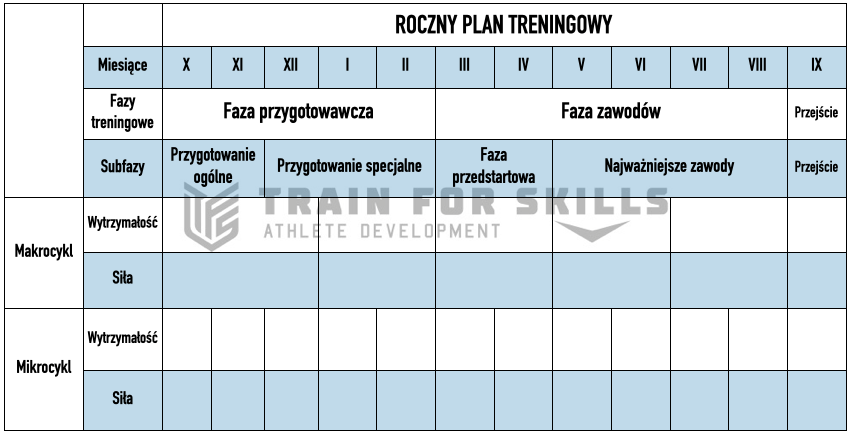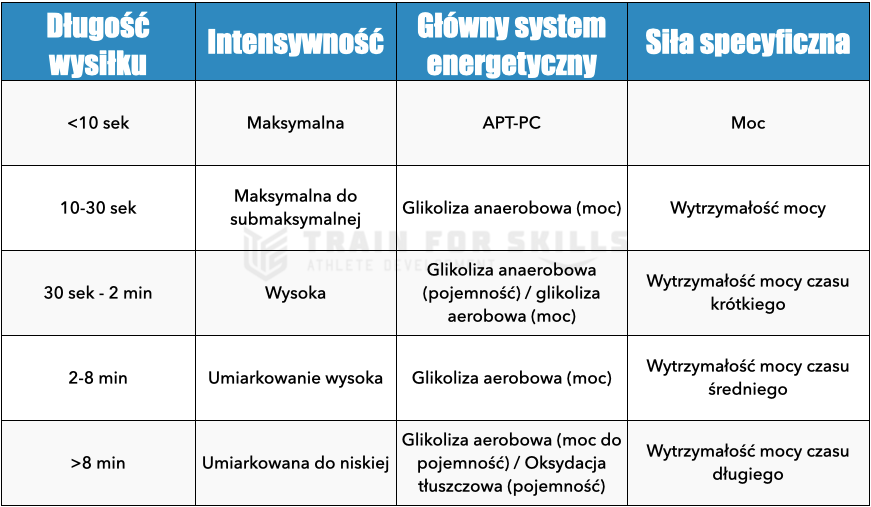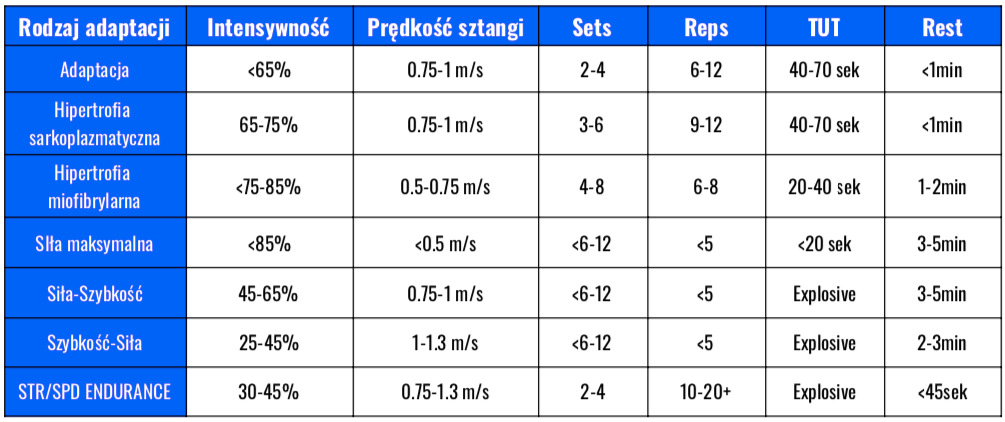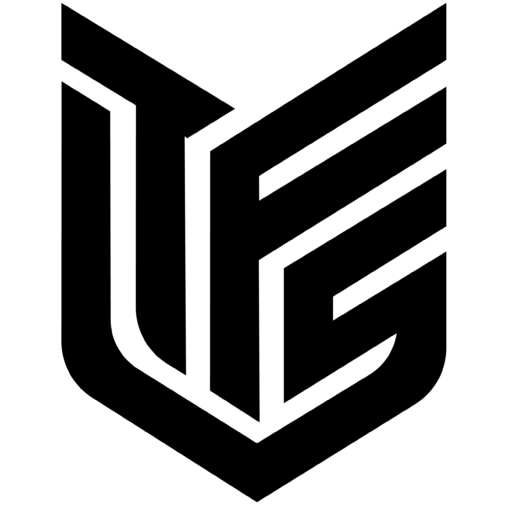Power training – training periodization part. V
Nowadays, almost every athlete trains according to a specific strength training program. Unfortunately, one of the most common mistakes in these programs is the failure to convert maximal strength to sport-specific strength such as power or muscular endurance. The lack of a conversion phase limits the athlete and deprives them of achieving their maximum athletic potential. In this article, we will focus on what power training is and how to do it.
Power Training is the 5th part in a series of articles on training periodization. I encourage you to read all the previous ones:
- Periodization part. I – annual training plan
- Periodization part. II – Anatomical Adaptation
- Periodization part. III – Hypertrophy
- Periodization part. IV – Maximum Strength
Conversion phase objective
The main goal of the conversion phase is to transfer the maximal force gained to the specific force needed for the discipline. Specific strength is that which is primarily responsible for an athlete’s performance during competition and determines athletic performance. Depending on the characteristics of the discipline, maximum force should be converted to one of the following 2 abilities and its derivatives:
- power (maximum power or power endurance)
- Muscular endurance (short time, intermediate time, or long time)
During this phase, it is extremely important to maintain the level of maximal strength developed in the earlier phase. Typically, combinations of typical strength exercises and sport-specific exercises are used for this purpose. If strength is not maintained, power levels will decrease through decreased neuromuscular adaptations.
When to use the conversion phase?
As you may have guessed, the conversion phase is designed to enhance an athlete’s performance. It is used as a link between the maximal strength phase and the maintenance phase (during the competitive/competitive/seasonal phase). You can see an example of the application period of the conversion phase in the tables below.


Specific force
It seems logical to assume that in sports that use specific abilities (power or endurance), training must reflect and shape those very qualities. The maximum strength built previously will now allow us to improve these parameters. Endurance athletes will focus on endurance. Speed and power athletes. Still others on both abilities. In this case, it is very important to keep the right balance between these features. The table below shows how the time of effort type of sport can affect the choice of strength and energy systems trained.

We can distinguish 2 types of sports:
- Sports requiring power – applying force as quickly as possible e.g. jumping, throwing, kicking and punching, sprinting, team sports
- Sports that require endurance – applying a lower level of force but for a long period of time e.g. swimming, medium and long distance running, traitlon, mountain and road cycling, skiing and many others.
Conversion phase characteristics
The human body can adapt to any environment and that includes any type of training. For this reason, proper training methods are extremely important as they dictate our outcome. By training a hypertrophy program year round we induce adaptations in the form of increased muscle mass (non-functional), but in return we lose power, speed and agility. Such an athlete cannot expect to move fast and have a lot of power. This is one of the common mistakes of beginners.
During the conversion phase, the athlete should be focused on technical and tactical training. Strength units should be kept to a necessary minimum and consist of a small number of exercises that are close to and replicate the physiological and biomechanical skills of the athlete. Power training allows for increased intra- and inter-muscular adaptation making the athlete’s movements technically clean and faster.
Power training
Power is a component of almost every sport and especially sports that require a high rate of development of strength, speed and agility. These sports include athletic disciplines such as sprints, long jump and high jump, javelin throw, hammer throw, but also team sports, racquet sports, gymnastics, and martial arts.
Definition of power training
There are many terms for power training including but not limited to “ dynamic force” , “ strength-speed” (which basically means power training with heavy weight) and “ speed-strength” (what power training with light weight is). While the terms can be confusing, it is most important that we know what power is in physiological and physical terms:
- rate of force production
- Resultant of force and power (P=F x V)
- the amount of work done per unit of time or
- The rate at which muscles can work (Enoka 2002).
For the above reasons, any increase in power is the result of an improved combination of abilities such as strength and speed. An athlete may be very strong and have a lot of muscle mass, but may not necessarily be able to perform contractions in a quick time frame.

Check out our Exercise Atlas and put the above knowledge into practice!
Benefits of power training
Power training using high speed affects adaptations at the central nervous system (CUN) level. As we know (from the previous section of this article), improvements in athletic performance are primarily based on neural adaptations (Sale 1986). This adaptation manifests itself in a shorter time required for activation of motor units, especially the fast-contracting IIX fibers (Hakkinen 1986). In advanced athletes, CUN adaptation in the form of more activated muscle fibers in less time.
One of the most important changes in nervous system function under the influence of power training is improved intermuscular coordination. This means better cooperation between antagonist and agonist muscles during movement. As a result, the CUN learns when to send a nerve impulse and to which muscles to make a contraction. Simply put, improving intermuscular coordination means improving an athlete’s ability to contract some muscles and relax others. This helps to increase the rate of contraction and speed of movement.
Remember
The greatest increase in power is achieved by a combination of high loads and speed of movement (typically at +/- 50%1RM load). In contrast, the highest level of power that my muscles can produce is based on the level of maximal strength and ability obtained in the previous phases. Power depends on 3 major components (Enoka 2002):
- number of active motor units
- the number of fast twitch muscle fibres recruited
- the rate of discharge of these muscle fibers (the rate of contraction and execution of nerve signals by these fibers)
The prerequisite for power training is the maximum involvement of the exerciser and the desire to accelerate through the entire range of motion!
Periodization of power training
Carlo Buzzichelli and Tudor Bompa proposed two phases in the periodization of power training. The first refers to the adaptation of the central nervous system to recruit as many fast-twitch fibers as possible. And the second phase of power training is designed to increase the rate of discharge by fast twitch fibers.

Phase I of power training
Its goal is to recruit as many fast-contracting muscle fibers as possible. This workout uses exercises with a load of about 70% of maximum weight (similar to the first phase of maximal strength) performed quickly and dynamically. This workout results in high stimulation of the neuromuscular system and increases the number of muscle fibers recruited. In order to avoid a decrease in strength, it is recommended to maintain a maximum strength training unit during this phase and the maintenance phase.
Phase II in power training
The goal of phase two in power training is to increase the discharge rate of fast twitch fibers. We can achieve this growth in 3 ways:
- Using relatively low loads up to 50%1RM in young and novice athletes and up to 60%1RM in advanced athletes
- Using any other lighter equipment such as med balls
- Application of plyometric training and discipline-specific agility drills
Training of this type facilitates the activation of high-threshold motor units and increases their discharge frequency.
Training methods in power shaping
- Isotonic/repetition – classic use of weight, e.g. barbell, and performing dynamic repetitions
- Ballistic – all exercises during which the force applied by an athlete significantly exceeds the weight of an object and its ejection occurs, e.g. medicine ball chest throw
- Power-Resisted method – is a kind of combination of isotonic, isometric and ballistic method. To explain what this consists of I will use the example of pull-ups on a bar. Exerciser starts the movement by bending arms, in the middle of pulling up the trainer stops his movement for 2-4 seconds and then lets go so that the athlete can complete the repetition of dynamic movements
- Plyometrics – one of the best methods to shape power. Plyometrics are exercises that use the stretch-contraction cycle (SSC) or myotatic stretch reflex. During the exercise, there is a rapid eccentric phase (stretching of the muscle) followed immediately by a concentric phase. Research indicates that if a muscle is stretched quickly it can contract much stronger and faster. The SSC cycle occurs, among other things. While running and jumping.
Summary
The conversion phase to specific strength plays an extremely important role in the annual training plan. Its presence (or lack thereof) can determine the final sports score.
Depending on the characteristics of the sport, we may focus more on power, muscular endurance, or both. The most important task of the athlete and coach is to determine the requirements and needs of the athlete and apply appropriate training methods.
Refs:
- Enoka R.M. (2002), Neuromechanical basis of human movement, 3rd edition, Champaign, Human Kinetics
- Sale D., (1986), Neural adaptation in strength and power training in human muscle power, Champaign, Human Kicetics, pp. 289-304
- Hakkinen K., (1986), “Training and detraining adaptations in elctromyography. Muscle fibre and force production characteristics of human leg extensor muscle with special reference to prolonged heavy resistance and explosive-type strength training”, Studies in Sport, Physical Education and Health
- T. Bompa, C. Buzzichelli (2015), Periodization Training For Sports, Human Kinetics
Author: Artur Hryszko




